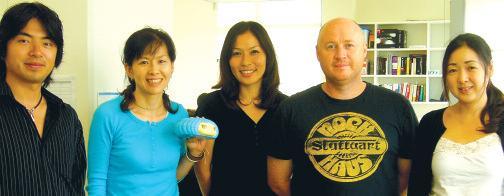TILEFILE
A creative avenue for the maverick Japanese
By Willhemina Wahlin
There are plenty of reasons why some Japanese might wish to escape the grind of their more traditional corporate workforce. Long hours and extreme dedication to the company are the norm, not the exception. A late-afternoon surf when the working day is done, perhaps, might be as remote a pleasure as the annual four-week sabbatical. It’s not surprising then, that an attraction between the more maverick Japanese professional and foreign companies is growing. Varying styles of recruitment, such as networking, incubation periods and flexibility of working hours all may be expletives within the more traditional Japanese corporations, but given an inch, many Japanese are flourishing within the breathable walls of some foreign businesses. One such firm is the start-up Internet company, TILEFILE. CEO and founder, David Bolliger, says that while his love affair with Japan may have kickstarted the close ties his business has with Japan, the very reason the less conservative Japanese professional seeks more relaxed alternatives is, nevertheless, what makes them such great employees: their levels of dedication and commitment still tend to remain higher than their foreign counterparts! In a start-up, this is the kind of boost that can become the soul of your business, and an ingredient of success.
The TILEFILE
Three years ago, David began explaining his vision to well-known American businessman and Tokyo resident, Richard Folsom. From there, it was serendipity, as Richard introduced him to the company that would become his Japanese venture partner, Netage. Now with its sister company in Shibuya (an area of Tokyo), TILEFILE Australia, is about to alpha launch the product they believe will be a tipping point in social networks, media sharing and distribution: the TILEFILE. As David puts it, TILEFILE is a “community connector”. “If 'You Tube' and 'My Space' are pyramids, TILEFILE is the Hieroglyph. We don't want to create another giant structure that ends up as a walled garden or cyber ghetto, rather, our approach is to make it a very small thing which flows through the Internet like a blood cell, that is not locked to any one web page or destination. TILEFILEs are a new type of micro site that snap together like Lego and behave quite differently to web pages or web sites."

'TILEFILEs are content agnostic, as they can contain any type of media: video, music, pictures, text, etc and they can even mash up various data sources. A TILEFILE has a front and a back. The front is primarily visual, while the back is like a mini social network, a place where you can read information and contribute to the TILEFILE. While the file itself can only be altered by authorised people, it’s designed so that its code can be cut and pasted to multiple destinations. This means a TILEFILE can literally be in a million places at once, and if you change the original, all the others will change automatically. This is a new form of social syndication, with exciting prospects for new forms of sharing and promotion.

In addition, the TILEFILE shows great potential for helping to better integrate large and small screens. “Most of the things that are promising about TILEFILE are child-like and if you just take a child’s view of a mobile screen, it’s small,” David explains. “When you look at the way which phones are already organised, there’s a kind of a crude tile, in the sense of a square image in a grid. Certainly most mobile phones, to my knowledge, when they handle photos, handle them as grids of images. So in a sense there’s something that’s been trying to happen. TILEFILE has just done away with the page, or if you like, ‘torn it out of the book’, so the user experience is one of free floating tiles which are easy to combine and recombine.”
Like ‘honey to a bee’
Ken Mikuni came to TILEFILE in almost the exact opposite way in which someone might be recruited within Japan. Ken was standing in line in an Australian Medicare office (the national health care system) with his friend, who was holding a bloodied gauze to a gash on his head that had come from a stray surf board. David joked, “Did one of our sharks get you?!” “Oh yes”, Ken’s friend replied, “a Great White”.
The two got talking and on discovering Ken’s background in IT, David invited him to his office for a chat about TILEFILE. The two have been great friends ever since and now Ken is employed as a programmer, systems engineer and system designer. He even has some input in the marketing team.
Ken agrees that the recruiting style in Australia can rely much more heavily on networking than in Japan. “In my opinion the recruitment styles are totally different. Japan is mostly open recruitment. They put the advertisements in the paper or on the Internet, or advertise through agencies and then they very carefully choose the people, which, sometimes fails. Here [in Australia] someone else says: ‘I’m looking for someone to do this job, do you know anyone who has these skills?’ In my experience this is very common, because I have a big network, and if someone tells me they are looking for someone specifically, say in IT, or a graphic designer, or perhaps a Japanese or Portuguese speaker, something like that, I think ‘Oh, OK, I know this guy, and I can introduce you’. So the style is pretty different.”
While being involved in a start-up has its risks for employees–risks some people may not be willing to take–Ken jumped at the chance to be involved in TILEFILE because of the nature of the job itself. “There are big possibilities for this company in the future. I can see a lot of cutting edge technology here, so we are challenged every day. If I am working in a big company maybe I am doing boring tasks, or the same thing every day, but coming here every day is exciting, challenging and if things don’t work, we try again. Of course venture businesses are very risky to survive in this field, but on the other hand there’s the possibility of a huge opportunity."
While his education was a far cry from IT (he studied marketing and econometrics), he was hired as a graduate in one of Japan’s largest IT firms. He received some company training, but largely taught himself in his 6 years of IT in Japan. However, he recognises that for most Japanese software engineers, programmers and designers, their Achilles heel is language. “I have another project that I am working on with the Japanese office,” explains Ken. “I can convince them, if I speak Japanese, with some specifications, but sometimes here I face the difficulty to convince them if I am speaking English.”
The language barrier is one of the reasons for the shortage of engineers within Japan and the steady upward trend of foreign engineers being recruited within Japanese corporations. In a report released by JETRO in 2006, Hokkaido’s (a large island off Japan’s mainland) concerted effort to increase the scale of its IT industry has been met with a severe shortage of indigenous engineers. By the end of March 2005, ‘Sapporo Valley’, as this IT center of Hokkaido is known, saw sales increase for a fourth straight year to JPY317.2 billion (USD2.6 billion), and employment rose to 17,346, ranking it second only to foodstuffs. The problem is leading to some new thought within the IT industry. “To that end, some companies have started to hire foreign engineers, which is still a rather uncommon practice for Japanese companies,” the report states. Other companies are opening subsidiaries in other countries, such as India, that regularly work in English. Interestingly, many companies are also targeting their recruitment ads to foreign engineers, as the industry’s perception of them changes from a mere cost-cutting resource, to valuable team members with high levels of skill and extensive experience. With that has come a slow change in recruitment style and many of the engineers are sent for an incubation period in Tokyo to see if the relationship is a match.

Losing an engineer with Ken’s level of expertise to a foreign firm is not necessarily in Japan’s best interests and at this stage Ken has no plans to return to his native country. “Of course, I love the Japanese people, but the working style here [in Australia] is totally different from Japan–definitely I will stay here! I love it here!”
One company responding to the changing needs of the industry if TILEFILE’s partner in Japan, Netage. “I think Netage in Tokyo is an unusual company because they do encourage the incubation mentality,” David explains.
There’s no doubt that Japan’s IT sector could boost its recruitment and retainment by providing more incubation and more challenging, creative environments within which to work. For David, Japan’s loss is Australia’s gain, as he snaps up the nation’s precious IT human resource. “They tend to have a lot more experience with large scale applications and security, banking, mobile phones–all directions that we’re heading in with the TILEFILE.”
Of course, the icing on the cake is the commitment David receives from his Japanese employees. “Pretty much without exception, all the Japanese who are working here in Sydney, are our best workers. So, that’s the first thing, fantastic workers; secondly, they’re happy and we’re happy. It’s a more playful, more relaxed, less hierarchical environment and I think the kind of Japanese who want to live and work in Australia are looking for that as an ingredient. At the same time we’re happy because there’s a professionalism and a commitment in the sense of ‘family’ that comes from a Japanese employee, and that’s just a tremendous way to build a company and Australians have a lot to learn from that spirit.”
An avenue for women
Wakana Farrell-Whelan moved to Australia permanently in February last year. Having been out of the workforce for five years in Japan whilst she raised her first child, she was faced with the arduous task of finding a job within a country she had no work experience in at all.
“I did everything that I could do. I registered on the Internet and with two Japanese temp agencies here in Sydney that introduce you to jobs with Japanese companies. I went for interviews with them two or three times, but because I had a big blank space in my resume, they rejected my application. I checked all the job advertisements on the Internet and anything that required Japanesespeaking people. I sent my resume to all of them, but TILEFILE was the first local company that I applied to. I knew I was going to be rejected, but I just tried.
To Wakana’s surprise, she received a call from David to come in for an interview. “We hired Wakana, because to me, it was very clear that she was looking for a job that she could give a lot of commitment to in order that she could progress to the next phase in her career. Those are great employees. That’s why we gave her a chance,” said David.
It was also clear from Wakana’s resume that her ability to teach herself was one of her greatest assets. For years she had been doing online courses and teaching herself graphics and web design software packages whilst raising her son. “I never had the proper training. I had designed web sites for friend’s businesses, but I never got to a professional level. David was interested in that point, that I could teach myself and learn,” she said.

For women raising young children in Japan, the IT industry might just be the ideal working solution–if, flexibility of working hours and location is available, or due consideration given to time spent away from the workforce before children reach school age. Difficult as it is for many women in Japan to re-enter the workforce within the field they last worked in, it would seem almost impossible for many to re-enter in a completely different field and receive the kind of training that was bestowed upon Ken in the early part of his career. Encouraging women into the IT industry in Japan, particularly bilingual and capable women such as Wakana, might just be part of Japan’s IT recruitment solution. “I still remember the first time I met David. As I was leaving the office, I asked him if I could send him a bit of my graphic work, adding, ‘It is not professional at all though.’ He then said to me, ‘Please send it to me. Everything starts small’. I was very impressed by that and felt the last 5 years of toiling away by myself had been vindicated at last!” She adds that she feels lucky to have stumbled across TILEFILE. “I think I was lucky being in Australia and finding such an opportunity and meeting a person like David. I think it’s a very ‘Australian’ kind of opportunity. In Japan everyone is very careful. They wouldn’t say you know, just try it, come on in and just try it.”
Wakana has now moved to a more challenging position within the TILEFILE marketing team. While she is aware her skills in that area are not to the level of her colleagues, she says, “I know I am better than I was last week. There are a lot of opportunities to get involved in his company if you show your enthusiasm. I could keep drawing illustrations everyday, but I want to be useful, I want to be a part of the company and I want to use this chance to improve myself more. David said to me ‘use this opportunity to become a professional IT marketing expert’. With that encouragement, that’s what I’m going to do.”
While Ken and Wakana’s road to TILEFILE may have been remarkably different, they have both found a place to unfurl their creative wings. At the same time, David’s love affair with Japan continues to grow, as both the Australian and Japanese offices of his fledgling venture, reap the benefits of his dedicated, experienced and creative Japanese partners and employees. TILEFILE innovation is, according to David, really happening with Japanese people in Sydney. Why is that, we ask? “Because if we fail we can all go to the beach!” It looks like they will have to balance work and beach, because failing isn’t likely. JI





